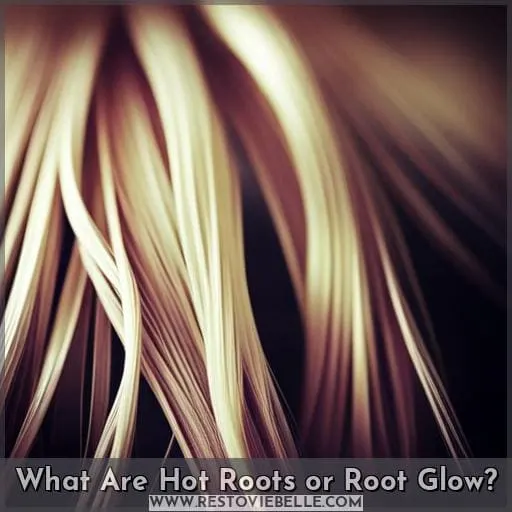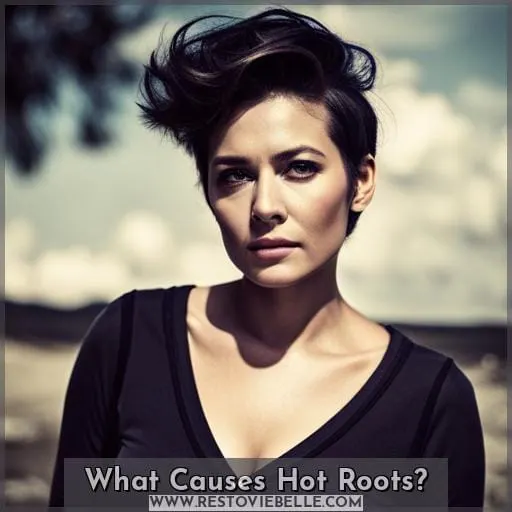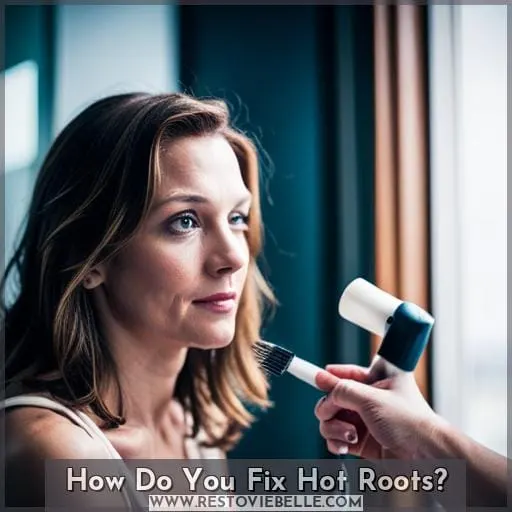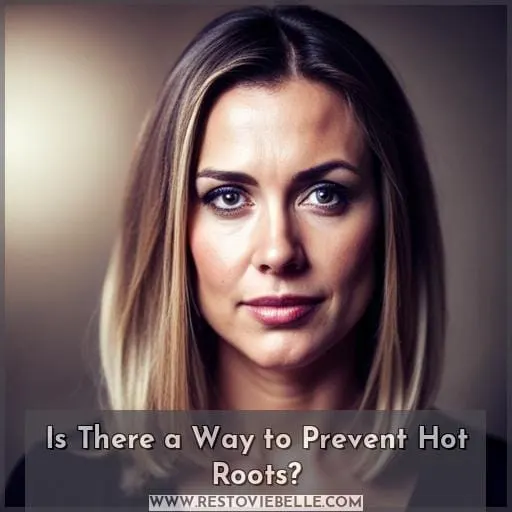This site is supported by our readers. We may earn a commission, at no cost to you, if you purchase through links.
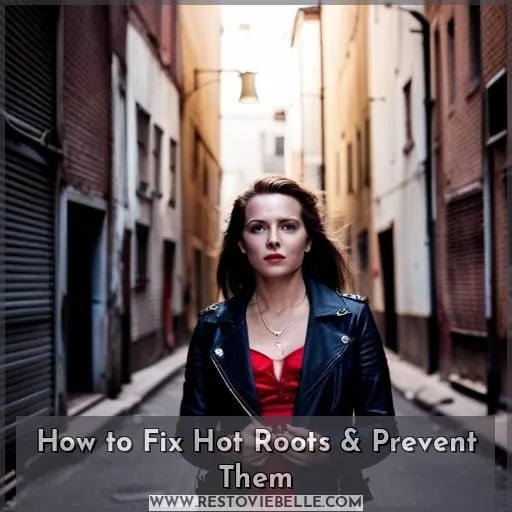 Ready to say goodbye to hot roots and achieve flawless hair color? Look no further! This article will guide you through the process of fixing hot roots and preventing them from happening again. You’ll learn why hot roots occur, the causes behind them, effective fixes for different hair colors, and valuable prevention tips.
Ready to say goodbye to hot roots and achieve flawless hair color? Look no further! This article will guide you through the process of fixing hot roots and preventing them from happening again. You’ll learn why hot roots occur, the causes behind them, effective fixes for different hair colors, and valuable prevention tips.
With these expert insights at your fingertips, you can confidently rock a stunning hairstyle that’s free from any unwanted root glow.
Table Of Contents
- Key Takeaways
- How Do Hot Roots Happen? How Do I Avoid Getting Hot Roots?
- What Are Hot Roots or Root Glow?
- What Causes Hot Roots?
- How Do You Fix Hot Roots?
- Is There a Way to Prevent Hot Roots?
- Frequently Asked Questions (FAQs)
- Can hot roots occur on any hair color?
- Can hot roots be fixed at home or should I consult a professional?
- Are hot roots more common when coloring previously-colored hair or when lightening natural hair?
- Are hot roots more noticeable on blonde hair compared to other hair colors?
- Can hot roots be prevented by using a lower developer or adjusting the formula?
- Conclusion
Key Takeaways
- Hot roots occur when the roots of the hair are noticeably warmer than the rest of the hair color.
- Hot roots can happen when trying to lighten previously colored hair or using a lighter or vivid color on natural or virgin hair.
- To prevent or fix hot roots, it is important to adjust hair color formulas and application techniques accordingly.
- Hot roots can be prevented by using a lower developer or adjusting the formula to add cool tones or toners.
How Do Hot Roots Happen? How Do I Avoid Getting Hot Roots?
To avoid getting hot roots, you can take preventive measures in your hair coloring process.
Hot roots happen when you try to color previously-colored hair a lighter shade or when lightening natural hair all over. The heat from the scalp causes the roots to appear warmer than the rest of your hair color, resulting in an unnatural look.
To fix hot roots at home, use a darker shade on dark hair and consider using a toner for blondes.
It’s always best to consult with a professional colorist if you need assistance correcting hot roots.
By following these tips, you can prevent hot root issues and achieve beautiful, balanced results in your future coloring sessions.
What Are Hot Roots or Root Glow?
Hot roots, also known as root glow, occur when the roots of your hair are noticeably warmer than the rest of your hair color.
- Trying to lighten previously-colored hair
- Using a lighter or vivid color on natural or virgin hair
Hot roots appear unnatural and unwanted because they create an imbalance in the overall hair color.
Why Does Root Glow Happen?
Root glow, also known as hot roots, occurs when the formula for the heat band from body temperature isn’t accounted for in your color formulation and application technique.
The heat band, located approximately ½ inch from the scalp, processes on scalp color to be lighter and brighter. This can result in unnatural warmth at the roots of blondes, brunettes, and redheads.
To prevent root glow or hot roots, adjust your formulas to accommodate this extra warmth near the scalp.
How to Fix Hot Roots for Blondes, Brunettes, and Redheads
If you’re a blonde, brunette, or redhead dealing with hot roots or root glow, there are specific ways to fix this issue and restore balance to your hair color.
Here’s how:
- Use a cool down formula
- Opt for a lower developer
- Consider applying a darker root shade
- Apply the color to the mids first
Remember these tips when fixing hot roots for blondes, brunettes, and redheads.
What Causes Hot Roots?
So, what exactly causes hot roots?
Hot roots occur when the formula for the hair color doesn’t account for the heat band that’s created by body temperature near the scalp.
This heat band processes on-scalp color to be lighter and brighter, resulting in warmer tones at the roots compared to the rest of your hair.
To prevent or fix hot roots, it’s important to adjust your formulas and application techniques accordingly.
Causes of hot roots
One of the main factors contributing to hot roots is improper formulation and application technique when coloring your hair.
This can include:
- Using a high developer
- Using a warm base
- Applying color to roots first
- Not using a toner
- Not applying color to mids and ends first
Fixes for hot roots
To fix hot roots, you can adjust the color by using a darker shade to balance out the warmth at your roots.
- Use a hair toner for blonde hot roots.
- Consider a long-lasting semi in natural brown for brunette hot roots.
- Do heavy freehand basin balayage or drop the roots to match for redhead hot roots.
Prevention tips for hot roots
To prevent hot roots, adjust your coloring technique and formula to account for the natural warmth that shows through during the hair coloring process.
- Use a low developer and cool formula.
- Apply color to mids/ends first.
- Opt for darker roots.
- Use double 10-volume developer.
How Do You Fix Hot Roots?
Now that you understand what causes hot roots and how to prevent them, let’s discuss how you can fix this hair color dilemma. Whether you have brassy blonde roots, orange roots, red roots, purple roots, or even green roots (yes it happens!), there are solutions to help correct the issue.
Here are three ways to fix your hot root problem:
- For blondes with brassy or yellowish tones at the root area: Apply a beige or cool natural semi-toner that matches the mid-lengths and ends of your hair.
- Brunettes dealing with brassiness in their root area: Use a long-lasting semi-permanent color in a natural brown shade that’s similar to the rest of your hair.
- Redheads struggling with overly vibrant or mismatched hues at their root area: Consider doing a heavy freehand basin balayage technique followed by applying a global toner for an overall boost in color and tone matching.
Remember if these tips don’t work for fixing your hot roots situation be sure consult with professional so they can give advice on next best steps!
Is There a Way to Prevent Hot Roots?
You can prevent hot roots by adjusting your color formulation and application technique to account for the heat band near the scalp.
- Use a lower developer: Opt for a lower volume developer when coloring the natural hair around the root. This will minimize excess lift and warmth.
- Cool down formula: Adjust your formula by adding cool tones or toners to counteract any potential warmth that may occur during processing.
- Opt for a darker root: Consider starting with a slightly darker shade at the roots, so any additional lift won’t result in overly warm tones.
- Use double 10-volume developer: Instead of using 20-volume developer, which can contribute to hotter roots, opt for double 10-volume developer as it provides gentler lifting action.
- Apply color to mids and ends first: When applying hair dye, start with coloring mids and ends before moving on to the roots.
By following these prevention techniques, you can avoid hot roots and achieve more balanced hair color results.
Frequently Asked Questions (FAQs)
Can hot roots occur on any hair color?
Hot roots can occur with any hair color, from blonde to black.
It happens when the formula doesn’t account for the heat band near your scalp, resulting in lighter and warmer roots.
Can hot roots be fixed at home or should I consult a professional?
To fix hot roots at home, consider using:
- A darker shade for brunettes and redheads
- A toner for blondes.
However, if you want the best results and assurance, it’s advisable to consult with a professional colorist.
Are hot roots more common when coloring previously-colored hair or when lightening natural hair?
Hot roots are more common when lightening natural hair.
The heat band from body temperature affects the color closer to the scalp, resulting in lighter and warmer roots.
Adjusting formulas and application techniques can help prevent hot roots in this scenario.
Are hot roots more noticeable on blonde hair compared to other hair colors?
Hot roots are more noticeable on blonde hair compared to other hair colors.
For example, if a blonde tries to lighten their natural hair all over, the hot roots may appear brighter and warmer than the rest of their hair color.
Can hot roots be prevented by using a lower developer or adjusting the formula?
To prevent hot roots, using a lower developer or adjusting the formula can be effective.
By considering the exposure of natural warmth and tailoring your formula accordingly, you can achieve balanced color without unwanted warmth at the roots.
Conclusion
Achieving flawless hair color is possible with the right knowledge and techniques.
By understanding the causes behind hot roots and implementing the appropriate fixes for different hair colors, you can say goodbye to unwanted root glow. Additionally, we provided valuable prevention tips to help you avoid hot roots in the future.
With these expert insights, you can confidently maintain stunning hair color without the hassle of hot roots.


